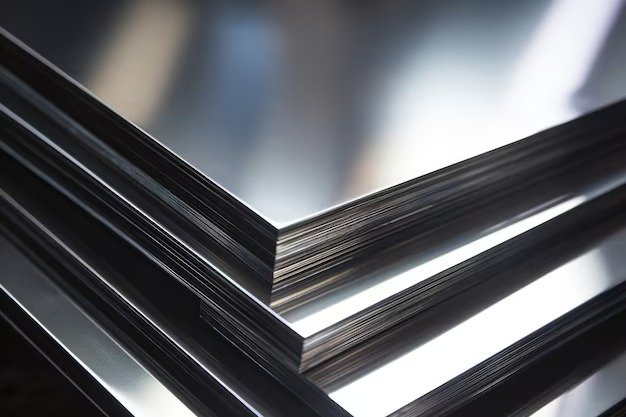Stainless steel sheets are renowned for their excellent corrosion resistance, durability, and aesthetic appeal, which makes them widely used across various industries, including construction, automotive, and food processing. However, despite their reputation for resisting corrosion, stainless steel sheets are not entirely immune to corrosion-related problems, especially in harsh environments. Understanding the factors that contribute to corrosion in stainless steel sheets and working with reliable stainless steel sheets suppliers to select the right material can help mitigate these issues effectively.
Understanding Corrosion in Stainless Steel Sheets
Stainless steel sheets gain their corrosion resistance primarily from the chromium content, which forms a thin, invisible oxide layer on the surface that prevents rust from forming. However, under certain conditions, this protective layer can break down, leading to various types of corrosion. To effectively overcome corrosion issues, it’s important to first understand the types of corrosion that stainless steel sheets may face:
1. Pitting Corrosion
Pitting corrosion occurs when small areas on the surface of stainless steel sheets become damaged, allowing localized corrosion to penetrate the material. This type of corrosion is often caused by exposure to chlorides, such as saltwater, and can lead to small pits or holes that compromise the sheet’s integrity.
To prevent pitting corrosion, it’s essential to select stainless steel sheets with higher chromium and molybdenum content, as these elements enhance the material’s resistance to chloride-induced corrosion. Stainless steel sheets suppliers can offer guidance on which alloys, such as 316 or 317 stainless steel, provide superior resistance in chloride-rich environments.
2. Crevice Corrosion
Crevice corrosion is another localized form of corrosion that occurs in confined spaces, such as gaps between joints, fasteners, or seals. In these areas, oxygen levels may become depleted, disrupting the protective oxide layer and allowing corrosion to occur.
To prevent crevice corrosion, proper design and maintenance are critical. Reducing the number of crevices and ensuring tight seals can help minimize corrosion risk. Additionally, working with experienced stainless steel sheets suppliers to select the right alloy for the application, such as those with increased resistance to oxygen-depleted environments, can significantly reduce the chances of crevice corrosion.
3. Galvanic Corrosion
Galvanic corrosion occurs when two dissimilar metals come into contact in the presence of an electrolyte, such as water. The less noble metal tends to corrode faster, while the more noble metal remains unaffected. In the case of stainless steel sheets, galvanic corrosion can occur when they are in contact with other metals, such as aluminum or carbon steel.
To avoid galvanic corrosion, it is important to prevent direct contact between dissimilar metals by using insulation materials, coatings, or isolators. When working with stainless steel sheets suppliers, ensure that the chosen stainless steel alloy is compatible with the other materials in the system to minimize the risk of galvanic corrosion.
Steps to Prevent Corrosion in Stainless Steel Sheets
Now that we’ve covered the types of corrosion that can affect stainless steel sheets, let’s delve into some practical steps that can help overcome these issues.
1. Choosing the Right Alloy
One of the most effective ways to combat corrosion in stainless steel sheets is by selecting the appropriate alloy for the specific environment. Different grades of stainless steel offer varying levels of corrosion resistance, with higher chromium, nickel, and molybdenum content providing better protection in aggressive environments.
For example, if your application involves exposure to marine environments or chemicals, grades such as 316 or 317 stainless steel are better suited due to their higher molybdenum content, which offers increased resistance to pitting and crevice corrosion. Stainless steel sheets suppliers can provide expert advice on the best grade for your specific needs based on the conditions your material will face.
2. Applying Protective Coatings
In environments where stainless steel sheets are exposed to harsh chemicals, humidity, or saltwater, applying protective coatings can provide an additional layer of defense against corrosion. Various coatings, such as epoxy, ceramic, or powder coatings, can be applied to enhance the corrosion resistance of stainless steel sheets.
These coatings act as a barrier between the stainless steel surface and corrosive elements, preventing the breakdown of the oxide layer. Consulting with stainless steel sheets suppliers can help you choose a coating that is compatible with your application and environmental conditions.
3. Proper Cleaning and Maintenance
Regular cleaning and maintenance play a critical role in preventing corrosion on stainless steel sheets. Dirt, debris, and contaminants, such as chlorides or sulfides, can accelerate the corrosion process if left on the surface. Therefore, it’s important to keep stainless steel sheets clean and free from corrosive agents.
Use non-abrasive cleaners, such as mild detergents or specialized stainless steel cleaners, to clean the surface. Avoid using harsh chemicals, such as bleach, which can damage the protective oxide layer. Rinse the sheets thoroughly with clean water and dry them completely to prevent water spots or residue from forming.
Stainless steel sheets suppliers often provide recommendations for cleaning products and maintenance procedures that help maintain the integrity of the sheets over time.
4. Avoiding Contamination
Stainless steel sheets can become contaminated with iron particles during fabrication, handling, or installation, which can lead to rust spots. This is known as “iron contamination” or “rouging,” and it occurs when stainless steel comes into contact with tools or surfaces made of carbon steel or other ferrous materials.
To prevent contamination, it is important to use tools and equipment specifically designed for stainless steel handling. For example, stainless steel wire brushes should be used for cleaning, and fabrication processes should be carried out in environments free of carbon steel debris. Stainless steel sheets suppliers can offer guidance on handling practices that minimize the risk of contamination.
Working with Stainless Steel Sheets Suppliers
Selecting the right stainless steel sheets suppliers is crucial in preventing corrosion and ensuring the long-term performance of your stainless steel sheets. Reputable suppliers not only offer high-quality materials but also provide valuable support and expertise in choosing the right alloys, coatings, and maintenance practices for your specific application.
1. Choosing High-Quality Stainless Steel Sheets
Ensure that your stainless steel sheets suppliers provide premium-grade materials that meet industry standards. High-quality stainless steel sheets are less likely to suffer from corrosion, as they contain the appropriate levels of chromium, nickel, and molybdenum to maintain the protective oxide layer.
2. Seeking Expert Advice
Working with experienced stainless steel sheets suppliers allows you to tap into their expertise in corrosion resistance and material selection. They can offer tailored advice on the best alloys for your environment, as well as recommendations for coatings, cleaning products, and maintenance practices.
3. Access to a Range of Products
The best stainless steel sheets suppliers offer a wide range of stainless steel grades and products, including sheets designed for corrosion-prone environments. This gives you the flexibility to choose materials that meet your project’s specific requirements.
Conclusion
Overcoming corrosion issues in stainless steel sheets requires a comprehensive understanding of the factors that contribute to corrosion and a proactive approach to prevention. By selecting the right alloy, applying protective coatings, maintaining proper cleaning practices, and avoiding contamination, you can significantly reduce the risk of corrosion and extend the lifespan of your stainless steel sheets.
Additionally, partnering with reputable stainless steel sheets suppliers who offer high-quality materials and expert advice is essential for ensuring that your sheets perform optimally in challenging environments. By following these best practices, you can effectively overcome corrosion issues and maximize the durability and longevity of your stainless steel sheets.



